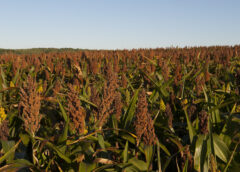Bioenergy sorghum hybrids can restore carbon levels in soil, improve soil fertility, provide biomass for biofuel production, and combat climate change.
By Crystal Wang
Bioenergy sorghum hybrids are sustainable crops that are being researched for their ability to restore carbon levels in the soil, improve soil fertility, reduce global warming, and provide biomass for biofuel production.
Carbon and soil fertility
The element carbon is an essential building block of the organic compounds vital to supporting life on Earth. For example, glucose is a common sugar that gives our cells energy via the foods that we eat. This essential compound is produced through photosynthesis in plants and is composed of carbon, hydrogen, and oxygen. Since organic compounds are essential to life, you and I—along with all other living organisms on Earth—need the element carbon to live.
Besides being an essential element in organic compounds, carbon boosts agricultural production. Farmers provide us with the fruits and vegetables that end up on our dinner tables. Efficient agricultural production is therefore essential to maintaining our food supply and health. Carbon contained within soil improves the soil’s fertility and its ability to hold water. Over time this element is naturally depleted from topsoil, negatively affecting crop production. In the United States alone, annual carbon levels in crop soil have been depleted by 50% or more over the past 10 decades. The depletion and restoration of carbon in agricultural soil is thus an important topic of research.
Bioenergy sorghum supports carbon replenishment
Soil carbon levels are maintained by the roots of crops that grow within the soil. Several factors regulate the rate of carbon restoration: root biomass (the total weight or quantity of roots present in a specified area or volume), the depth and distribution of root systems, root biomass composition (in other words, what the roots are made of), and the microorganisms present in the soil. Of particular interest to soil researchers is a group of crops called bioenergy sorghum hybrids. According to a study by Texas A&M AgriLife Research, these annual crops have large and deep root systems, enhancing their ability to restore carbon levels in the soil. In addition, bioenergy sorghum has a large seasonal biomass yield and roots that use water efficiently. These traits make bioenergy sorghum hybrids a highly sustainable solution for carbon replenishment.
Climate change and biofuel
In addition to enriching soil, growing bioenergy sorghum hybrids may help slow climate change, an environmental issue that adversely affects Earth’s ecosystems. Carbon dioxide released from burning fossil fuels is a greenhouse gas that contributes to rising global temperatures. Since carbon dioxide is broken down via photosynthesis to provide carbon to root systems, the soil carbon restoration process reduces the level of carbon dioxide in the air. The deep root system of bioenergy sorghum is particularly suitable for carbon restoration. Therefore, bioenergy sorghum hybrids remove more carbon dioxide from the atmosphere compared to other crops.
Bioenergy sorghum is also drought resistant, making it a useful crop to grow on land that is unable to hold moisture efficiently. Growing bioenergy sorghum in these regions could provide a substantial amount of biomass for biofuel production. Biofuel, unlike fossil fuel, does not release harmful greenhouse gasses into the air when burned. Burning biofuels instead of fossil fuels is therefore an environmentally friendly alternative.
Nitrogen use efficiency
Farmers add N-fertilizer (nitrogen containing fertilizer) to soil early in the growing season to improve crop yield. Bioenergy sorghum uses this nitrogen highly efficiently, as the crop’s root systems contain nitrogen-fixing bacteria and fungi that absorb nitrogen from surrounding soil. Also, deep sorghum roots are ideally positioned to remove excess N-fertilizer leftover from the growth of previous crops. This is economically efficient, as it prevents the loss of nutrients through fertilizer run-off. N-fertilizer use also releases nitrous oxide, another greenhouse gas that contributes to rising global temperatures. Thus, growing nitrogen-efficient bioenergy sorghum hybrids instead of other more nitrogen-demanding crops can reduce nitrous oxide emissions, lessening undesirable environmental impact.
Bioenergy sorghum roots
The root system of bioenergy sorghum hybrids offers many advantages in terms of economic efficiency and sustainability. In addition to carbon, bioenergy sorghum roots are able to transport nitrogen, phosphate, and other nutrients. Therefore, supplemental nutrients do not need to be supplied to the crop, making bioenergy sorghum less expensive to grow. Since bioenergy sorghum has a long growing season, its root systems can grow deeper and accumulate more biomass compared to crops with shorter growing seasons (such as maize). This extra biomass provides ample material for producing sustainable, environmentally friendly biofuels.
Conclusion
Drought-resistant bioenergy sorghum hybrids offer economically efficient “green” results. Bioenergy sorghum hybrids can be used to boost soil fertility while providing a sustainable source of biofuel. These hybrids also combat rising global temperatures by reducing the levels of greenhouse gas in the atmosphere. Overall, the unique properties of bioenergy sorghum hybrids may make them the sustainable crop of the future.
Reference
Lamb, A., Marshall-Colon, A., McKinley, B., Morgan, C., Mullet, J., Rooney, W., & Weers, B. (2021). Bioenergy sorghum’s deep roots: A key to sustainable biomass production on annual cropland. GCB-Bioenergy, 14(2), 105-241. https://doi.org/10.1111/gcbb.12907
Image credit: K-State Research and Extension; license CC by 2.0
About the Author
Crystal Wang earned her bachelor’s degree in biochemistry from Binghamton University and enjoys blogging about science. Her latest project is The Buzz, a blog about insects and entomology. Connect with Crystal on Facebook.

